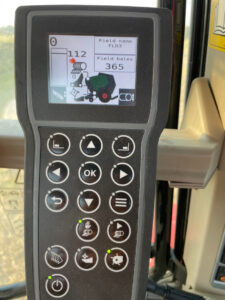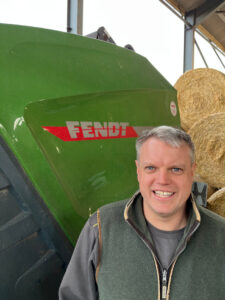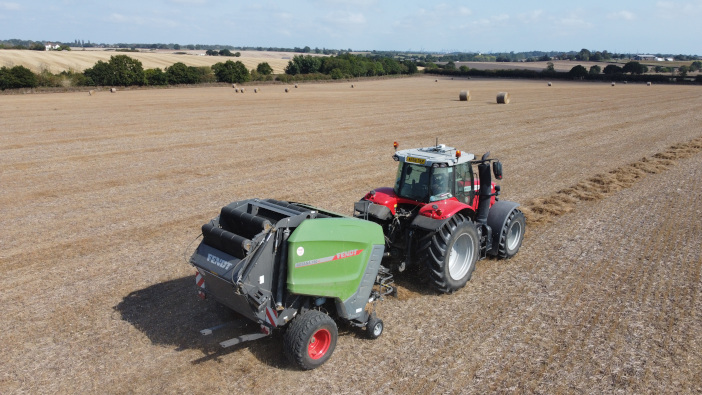The increased efficiencies achieved through running a new Fendt baler have more than justified the cost to upgrade for one hay and haylage producer in Essex.
After suffering from regular breakdowns and constant net issues, farmer and contractor Alex Cullen has experienced immediate benefits following his first season running a new Fendt Rotana 160 V, that replaced his ageing 15-year-old Welger RP 535.
He explains: “The biggest improvement with the Rotana has been the updated net wrap system, that was a constant issue on my old baler, causing me vast amounts of downtime. Output has also increased and I can operate 2-3kph faster in heavy grass crops which, as a single operator handling all the grassland jobs, allows me to confidently complete the baling to preserve quality.”
Alex farms on the outskirts of Harwich, in Essex, and set up the hay and haylage side of Cullen Family Farming in 2018 to supply horse yards within a 30-mile radius of the farm. The farm is predominately arable land, along with a thriving pumpkin patch, but Alex says the grass production has become a significant part of the business.
“I’ll bale between 3000 and 5000 bales per season, depending on the crops and demand. As I do most of the jobs myself, reliability is essential, along with implements that are easy to switch between tractors. I tend to rake up a large area of grass in the morning, so I need to be confident that I can get it baled before the quality starts to deteriorate or the weather turns later in the day.”
Wait for the right model
After a successful demo of the Fendt Rotana in 2022, Alex was happy to wait for the latest model, which addressed some of the issues he was having with his old Welger. His Rotana 160 V arrived in early 2024 and includes the forced net feed to the chamber, which improves the start of the binding process.
There had also been improvements to the design around the net roll to avoid straw and grass building up and impacting the net feed. Alex says these two improvements were worth waiting for.
“The net feed into the chamber and build-up of debris, especially in short straw crops, was costing me around 10 minutes of downtime every hour. As the debris built up, it would affect the width of net binding on the bales and lead to the full width not being covered. The new Rotana has completely solved these issues while increasing output at the same time.”
There is no foam roller on the net feed design and, instead, a metal bar stretches and feeds the net across the full width of the bale. This means Alex can save money by purchasing the correct width net in confidence that the baler will apply it accurately rather than using oversized rolls to compensate for the inaccurate binding.
 New features
New features
Initially, Alex was looking at a second-hand baler with a low bale count, but after discussions with his salesman at dealer TNS, the option of Fendt Finance to spread the cost of a new machine over additional years, proved more attractive. The Rotana complements the other hay and forage equipment that has been progressively upgraded over the past four seasons.
“The Rotana has been the final part of our grassland machinery upgrade and allows us to have complete control over timings to ensure quality, while offering a full contracting service to local farmers.”
The baler is powered by a MF 7720 S Dyna-VT and Alex highlights the feed into the Rotana and ‘Flex’ floor as huge benefits with changing crops during the day and season.
“I’ve only had the slip clutch engage twice this season as the flex floor automatically adjusts to accommodate the changing crop quantities. It offers peace of mind to push on a bit quicker if required as the baler’s ability to cope with lumps in swaths has been a big improvement.”
Greater output
The increased output has allowed speeds of 8-10kph in first cut grass crops and in straw 12-14kph is easily achievable. Alex says the Rotana has greater capacity, despite being a smaller chamber than his last one.
“I went for the Rotana 160 V as the demand for 1.8m bales is tiny. A lot of my customers handle the bales by hand, so 1.6m is big enough. We have the Xtracut knife bank and can engage these when required as the knives remain on the machine when not in use.”

The Rotana screen has also been praised for its ease of use and field recording, which is a vast improvement on writing down bale numbers on a scrap of paper. It also alerts Alex if a bale hasn’t bound, either due to low net or another issue, which avoids him opening the door and needing to rebale broken ones.
“Baling for multiple customers and different fields can have its challenges for logging bale numbers, but the new screen can store up to 23 fields, so I can keep a constant tally. It also allows me to compare yield from certain fields and monitor these each year, while streamlining invoicing.
“I knew our old machine needed changing, but the multiple improvements the Rotana has offered our business have been useful. We are making consistent, good quality bales, with a reliable machine that is easy to use,” concludes Alex.


